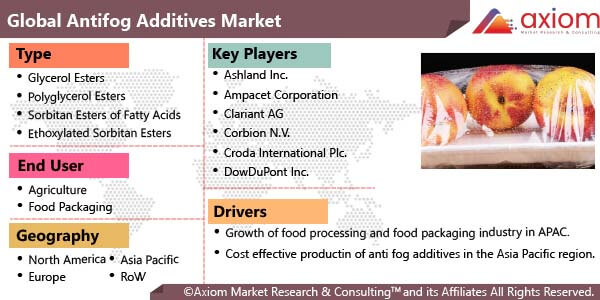The anti-fogging additives or agents reduce the surface tension which results in a thin and continuous layer of water of the surface. These additives allow water to spread into a continuous and uniform transparent layer on the surface of films. This results in improved light transmission and transparency which has benefits in both agricultural and food packaging applications. There are two routes the packaging industry uses to minimize the formation of fog on sheet, film, or thermoformed articles: internal additives or external topical coatings. Internal antifog additives are generally non-ionic surfactants which are added at the film producers mainly in form of concentrates or master batches. These additives usually have a certain level of incompatibility with the polymer matrix they are blended into, and as a result, migrate to the surface.
Antifog Additives Market Outlook
The global demand for antifog additives market is booming because of increase in demand from greenhouses for use in crop cultivation process and growth of the food processing & food packaging sectors in India and China. Anti-fog additives used in agriculture industries require specifically desired properties, such as high durability in agriculture applications and variable temperature sustainability range. Thus, manufacturers are focusing on increasing the quality of products, which is one of the ongoing key trends in the anti-fog additives market.
Antifog Additives Market Segmental Overview
The report analyses the global antifog additives market based on type, end use industry and geography.
Antifog Additives Market by Type
Various types of antifog additives considered in this report are glycerol esters, polyglycerol esters, sorbitan esters of fatty acids, ethoxylated sorbitan esters, polyoxyethylene esters of oleic acid and others. Among various types, the glycerol esters type segment is projected to lead the market during the forecast period 2020 to 2026, both in terms of value and volume.
Antifog Additives Market by End Use Industry
Moreover, the major end use industries of the antifog additives are agriculture, food packaging and others. The market dominance of anti-fog additives application in food packaging is attributed to the improved transparency of packaging films along with the high longevity of the packed foodstuffs using this product. Furthermore, better visibility and aesthetic appeal provided to the product will drive demand in the forecast period.
Antifog Additives Market by Geography
By geography, the global antifog additives market is studied across the countries of key regions such as, North America, Europe, Asia Pacific and rest of the world. The APAC region accounted highest CAGR of the global antifog additives market in 2019. In APAC, China is one of the largest consumers of anti-fog additives, followed by India and Japan. Asia Pacific is a potential market due to the presences of developing countries such as China and India. Furthermore, modern lifestyle and food preference in these countries is expected to boost the market in the region.
Antifog Additives Market Key Players
The major companies operating in the antifog additives market include Ashland Inc. (U.S.), Ampacet Corporation (U.S.), Clariant AG (Switzerland), Corbion N.V. (Netherlands), Croda International Plc. (U.K.), DowDuPont Inc. (U.S.), Lehmann&Voss&Co. (Germany), Emery Oleochemicals (Malaysia), Evonik Industries AG (Germany), Fine Organics Industries Ltd (India), Gabriel-Chemie Company M.B.H. (Austria), High Tecnology Masterbatches S.L. (Spain), Ilshinwells (Korea), IOI Oleo GmbH (Germany), JJ Plastalloy Pvt. Ltd (India), Nassolkem (P) Ltd. (India), Nouryon (Netherlands), Palsgaard A/S (Denmark), PCC SE (Germany), Polyone Corporation (U.S.), Polyvel Inc. (U.S.), Riken Vitamin Co., Ltd. (Japan), Sabo S.P.A. (Italy), Tosaf Compounds Ltd. (Israel) and VIBA S.p.A. (Italy).











